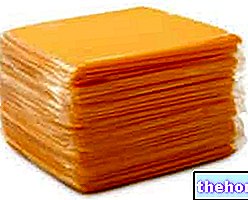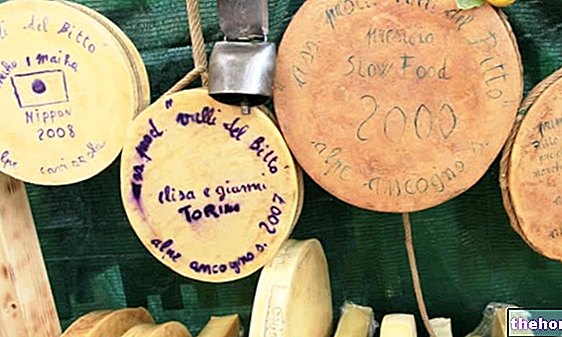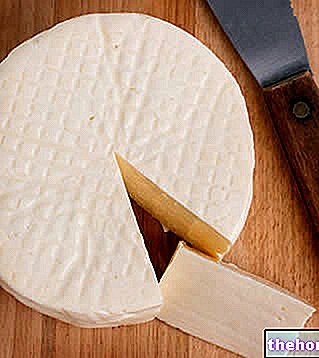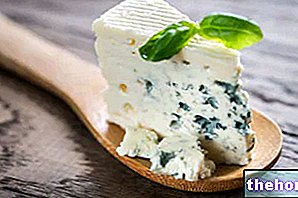What is Burrata
Burrata is a fresh cheese of Italian origin - typical of the Puglia region - made from whole, raw or pasteurized cow's milk.
The burrata is characterized by an outer layer of solid mozzarella and a heart enriched with fresh cream or butter. The consistency is softer than that of mozzarella; even more towards the inside.

The burrata is generally served alone, perhaps with a drizzle of oil, basil, some tomatoes and tasty anchovies. The temperature of the cheese must be fresh or ambient, absolutely not hot or too cold (unless it is part of other recipes) .
Burrata has a high energy intake and a rather long digestibility; it contains significant quantities of lactose and as such falls into the group of dairy products so called “dairy products”.
Nutritional Characteristics
Burrata is a food of animal origin, obtained from the processing of milk and cream by means of rennet. This means that, even if the basic food is allowed in the side-ovo-vegetarian diet (not in the vegan one), the presence of rennet still precludes its use.
Burrata is a product that belongs to the II group of foods; as such, it plays above all the role of high biological value protein source, calcium, phosphorus and riboflavin (vitamin B2).
It provides a "high energy concentration, provided above all by lipids, followed by proteins and finally by carbohydrates. The fatty acids of burrata are mainly saturated, the peptides rich in essential amino acids and simple carbohydrates (lactose). Cholesterol is very abundant and the fibers absent.

Nutritional values (per 100 g of edible portion)
The mineral salts contained in burrata are mainly calcium, phosphorus and sodium, while the vitamin profile is essentially made up of retinol equivalents (vit A), riboflavin (vit B2) and some tocopherols (vit E).
Burrata is a food that does not lend itself to the nutrition of the overweight person or person suffering from hypercholesterolemia.
The sodium content is not alarming, which is why a small portion of burrata could also be included in the diet against hypertension (only in the absence of overweight).
The amount of calcium is useful for those who must ensure a high intake of this mineral in the diet, such as those in growth or at risk of osteoporosis.
The average portion of burrata is about 50-100g.
NB. Burrata is NOT a food to be seasoned with oil.
Service and Storage
If the burrata is opened or cut, the scraps and the cream inside come out; also for this reason, in general, the started burrata must be finished in the same meal.
This cheese has a rich, buttery flavor, and a succulent texture typified by the creamy spill.
The burrata should be consumed within 24 hours of purchase; after 48 hours it should be considered no longer fresh (tendentially acidic and yellowish).
The burrata is particularly suitable for the packaging of appetizers, salads, sandwiches (together with raw ham), bruschetta, caprese (together with fresh tomato, with oregano or basil, extra virgin olive oil and ground black pepper) and condiments for the pasta.
Production
The production of burrata begins in a similar way to many other cheeses, that is with the formation of the curd (mixing the rennet with raw or hot pasteurized, slightly acidified milk).
Unlike most cheeses, the curds of mozzarella and burrata are dipped in warm, slightly salted water (or whey). The whole is then subjected to kneading and drawing to develop the typical elastic fibers. Finally, the stretched curd of mozzarella and burrata is processed to obtain various shapes and sizes.
Video Recipe: Homemade Mozzarella
However, when the burrata is produced, at the moment of the processing of the stretched curd (after the kneading and the drafting), it is manipulated to obtain the shape of a bundle. This is then filled with small rags of mozzarella (leftovers) and cream. of milk (a compound called "stracciatella"). Finally, this "pseudo container" is closed, wrapped in the green leaves of asphodel (plant of the Genus Asphodelus), tied and moistened with whey.
Asphodel leaves are an indicator of quality since, if still green at the time of serving, they indicate the highest level of freshness obtainable. Only recently, the cheese is sold in a plastic bag or rigid container.
NB. Despite the exceptional taste, buffalo burrata is not considered an equally traditional food.
Pasta with Zucchini and Burrata
Problems with playing the video? Reload the video from youtube.
- Go to the Video Page
- Go to the Video Recipes Section
- Watch the video on youtube
Background
Burrata is a typical product of Murgia, an Apulian subregion.
It is a milk-based food, obtained thanks to the use of bovine rennet (digestive juice of young calves); later, the milk cream is also added to the burrata.
The burrata was invented in 1956 (official date), but it cannot be excluded that the Bianchino company (from Andria) started producing it much earlier.
The discovery of the burrata was almost entirely accidental; it is said that, being unable by bad weather (famous snowfall of 1956) to transfer a load of cream, Bianchino chose to keep it inside the mozzarella with other processing cuttings.
Given the success, after the commitment of some dairies, burrata became more widely available on the market.
To its advantage, born as an artisan cheese, burrata has maintained its qualitative status even after the start of industrial production.
Burrata is also produced in the United States, particularly in artisan cheese shops in eastern coastal cities colonized by a certain Italian American population.
Today, the Andria burrata enjoys the recognition of the IGP (Protected Geographical Indication) mark.
Milk, Dairy Products and Cheeses Asiago Brie Burrata Caciocavallo Rennet Camembert Cheddar Milk Cream Crescenza Emmental Feta Milk Flakes Fontina Herbal Cheeses Lean Cheeses Cheeses rich in calcium Gorgonzola Gouda Grana Padano Gruyere Kéfalair Adapted milk Artificial milk Condensed milk Asphyxiated milk Goat's milk Sheep's milk Rice milk Soy milk Powdered milk and concentrated milk Skimmed and semi-skimmed milk Lactose-free milk Milk Vegetable milk Dairy products Lerdammer Mascarpone Montasio Buffalo mozzarella Mozzarella Whipped cream Cooking cream Fresh cream Parmigiano Reggiano Pecorino Philadelphia Primo Sale Provolone Ricotta Robiola Roquefort Scamorza Sottilette Squacquerone Taleggio Tomino Yogurt OTHER ARTICLES MILK AND DERIVATIVES Categories Alcoholic foods Meat Cereals and derivatives Sweeteners Sweets Offal Fruit Dried fruit Milk and derivatives Legumes Oils and fats Fish and fishery products Cold cuts S pezie Vegetables Health recipes Appetizers Bread, Pizza and Brioche First courses Second courses Vegetables and Salads Sweets and Desserts Ice creams and sorbets Syrups, liqueurs and grappa Basic preparations ---- In the kitchen with leftovers Carnival recipes Christmas recipes Light diet recipes Women's Day, Mum, Dad Recipes Functional Recipes International Recipes Easter Recipes Recipes for Celiacs Recipes for Diabetics Recipes for Holidays Recipes for Valentine's Day Recipes for Vegetarians Protein Recipes Regional Recipes Vegan Recipes




























